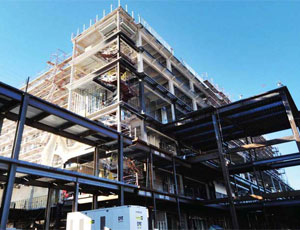USACE districts across the Southeast Construction region are busy delivering a long list of military and civil projects. While these projects often have the intent of supporting either today’s soldiers and their families, or another critical natural resource, the environment, the magnitude of projects being delivered by today’s Corps is also giving a much-needed boost to the region’s construction and design industries.
This year, the magazine is taking a slightly different approach and is recognizing all of the districts of the U.S. Army Corps of Engineers working in the four-state region of Florida, Georgia, North Carolina and South Carolina. When looking at the entirety of work that the group is delivering to the region—and, really, the nation—we believe it’s hard to argue with our selection of the USACE as the magazine’s “Owner of the Year” for 2010.
A confluence of factors has put the Corps in high gear. The continuing Base Realignment and Closure Program; ongoing military campaigns in Iraq and Afghanistan; a delayed-but-now resurgent federal commitment to funding Everglades restoration; and the hurricane-induced need to renourish a large number of the Southeast’s coastal beaches are all pushing the various USACE districts to a new level of project delivery.
Transformation The U.S. Army Corps of Engineers has more than $2.7 billion in military and civil projects—from barracks to command centers to dredging operations—under way in Florida, Georgia and the Carolinas.
“The armed forces have been going through transformation,” says Robert G. Holland, public affairs officer for the South Atlantic Division of the Corps in Atlanta. “It accelerated at 9/11, when the Defense Department realized that maybe it wasn’t postured for the kinds of conflicts it was going to have to face, so a lot of this is related to reconfiguring how military units come together and where they are based.”
Much of the $2 billion in military work involves upgrading facilities and adding medical centers, housing, day care and other amenities.
“The covenant the Army has made with its soldiers and families is to improve the living, training and work facilities to meet the needs of the current family,” says Billy Birdwell, spokesperson for the Savannah District, which has one of the Corps’ largest military construction workloads, with more than $2.1 billion in MILCON work in fiscal year 2009 (October 2008-September 2009) and an expected $1.4 billion in fiscal year 2010.
The South Atlantic Division has received about $760 million in American Recovery and Reinvestment Act funding, which allowed the start of many projects that were ready to build but still in need of funding. All of the stimulus projects have been awarded.
The work includes a $750,000 snagging and clearing operation on the Ocklawaha River in Florida and a $250,000 snagging and clearing operation on the Withlacoochee River, also in Florida. Leno Hauling and Dredging of Miami is performing both projects.
While the federal government could provide additional stimulus money, the Corps has not received a second call for projects, but Holland says it would be ready if that were to happen.
The military’s Base Realignment and Closure program has triggered significant work in the Southeast, but that work is winding down.
“There will be less going on after 2011 and into 2012,” Holland says. “The military program will decline, probably significantly, but no one has a real handle on exactly what might happen between now and then.”
The Defense Department not only determined a need for more facilities, it charged the Corps with building them more cheaply and faster than before, Holland says.
“We had to retool our capabilities and contracting, construction and design methods,” he adds. “All underwent revolutionary change from the way we used to do business 20 years ago.”
The Corps often relies on design-build, which saves time and money, Birdwell says. In addition, it has placed an emphasis on standard designs, modified to accommodate a site.
“That also helps the soldiers,” Birdwell says. “When a soldier moves from one location to another location, the soldier knows where he will find his company headquarters and where the uniforms are supposed to hang.”
The Corps also has focused on greener buildings. Since 2006, all military construction must meet LEED-Silver certification criteria. Some projects in the Savannah District have exceeded that. The Corps anticipates a $2.6-million fire station at Fort Bragg, N.C., being built by R.A. Connelly of Bradenton, Fla., will achieve Platinum certification.
Military The $300-million, 700,000-sq-ft Forces Command U.S. Army Reserve Command Headquarters at Fort Bragg began in 2008 and is scheduled for completion in 2011. The Forces and Reserve commands are relocating from Fort McPherson, Ga.
The new facility will provide office and conference space for nearly 2,800 personnel. Hensel Phelps Construction Co. of Chantilly, Va., topped out the six-story structure in December.
Two other command headquarters are under construction. Hensel Phelps also is building the $237-million, 630,425-sq-ft Southern Command Headquarters in Doral, Fla. Clark Construction Group of Tampa began work in July on the $61-million U.S. Central Command Headquarters at MacDill Air Force Base in Tampa.
At Fort Stewart, Ga., the Corps is building a $315-million Infantry Brigade Combat Team Complex, designed to accommodate 3,500 soldiers and 950 wheeled vehicles. It consists of barracks, a dining facility, physical fitness center, clinic and maintenance buildings and is slated for completion in fall 2011. Five of the six contracts have been awarded.
Walbridge Aldinger of Detroit received a $150-million contract for the design and construction of six company operations facilities, six tactical equipment maintenance...



Post a comment to this article
Report Abusive Comment